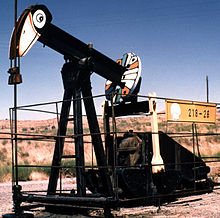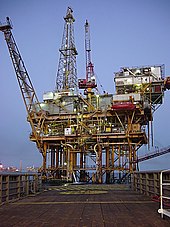Gasoline is produced in oil refineries. Material that is separated from crude oil via distillation, called virgin or straight-run gasoline, does not meet the required specifications for modern engines (in particular octane rating; see below), but will form part of the blend.
The bulk of a typical gasoline consists of hydrocarbons with between 4 and 12 carbon atoms per molecule (commonly referred to as C4-C12).
Many of the hydrocarbons are considered hazardous substances and are regulated in the United States by the Occupational Safety and Health Administration. The material safety data sheet for unleaded gasoline shows at least fifteen hazardous chemicals occurring in various amounts, including benzene (up to 5% by volume), toluene (up to 35% by volume),naphthalene (up to 1% by volume), trimethylbenzene (up to 7% by volume), Methyl tert-butyl ether (MTBE) (up to 18% by volume, in some states) and about ten others.
The various refinery streams blended together to make gasoline all have different characteristics. Some important streams are:
- reformate, produced in a catalytic reformer with a high octane rating and high aromatic content, and very low olefins (alkenes).
- cat cracked gasoline or cat cracked naphtha, produced from a catalytic cracker, with a moderate octane rating, high olefins (alkene) content, and moderate aromatics level.
- hydrocrackate (heavy, mid, and light) produced from a hydrocracker, with medium to low octane rating and moderate aromatic levels.
- virgin or straight-run naphtha, directly from crude oil with low octane rating, low aromatics (depending on the grade of crude oil), some naphthenes (cycloalkanes) and no olefins (alkenes).
- alkylate, produced in an alkylation unit, with a high octane rating and which is pure paraffin (alkane), mainly branched chains.
- isomerate (various names), which is obtained by isomerizing the pentane and hexane in light virgin naphthas to yield their higher octane isomers.
The terms above are the jargons used in the oil industry. The exact terminology for these streams varies by refinery and by country.
Overall, a typical gasoline is predominantly a mixture of paraffins (alkanes), naphthenes (cycloalkanes), and olefins (alkenes). The actual ratio depends on:
- the oil refinery that makes the gasoline, as not all refineries have the same set of processing units;
- crude oil feed used by the refinery;
- the grade of gasoline, in particular, the octane rating.
Currently, many countries set limits on gasoline aromatics in general, benzene in particular, and olefin (alkene) content. Such regulations led to increasing preference for high octane pure paraffin (alkane) components, such as alkylate, and is forcing refineries to add processing units to reduce benzene content.
Gasoline can also contain other organic compounds such as organic ethers (deliberately added), plus small levels of contaminants, in particular sulfur compounds such asdisulfides and thiophenes. Some contaminants, in particular thiols and hydrogen sulfide, must be removed because they cause corrosion in engines. Sulfur compounds are usually removed by hydrotreating, yielding hydrogen sulfide, which can then be transformed into elemental sulfur via the Claus process.
Density
The specific gravity (or relative density) of gasoline ranges from 0.71–0.77 (0.026 lb/in3; 719.7 kg/m3; 6.073 lb/US gal; 7.29 lb/imp gal), higher densities having a greater volume of aromatics. Gasoline floats on water; water cannot generally be used to extinguish a gasoline fire, unless used in a fine mist.



No comments:
Post a Comment